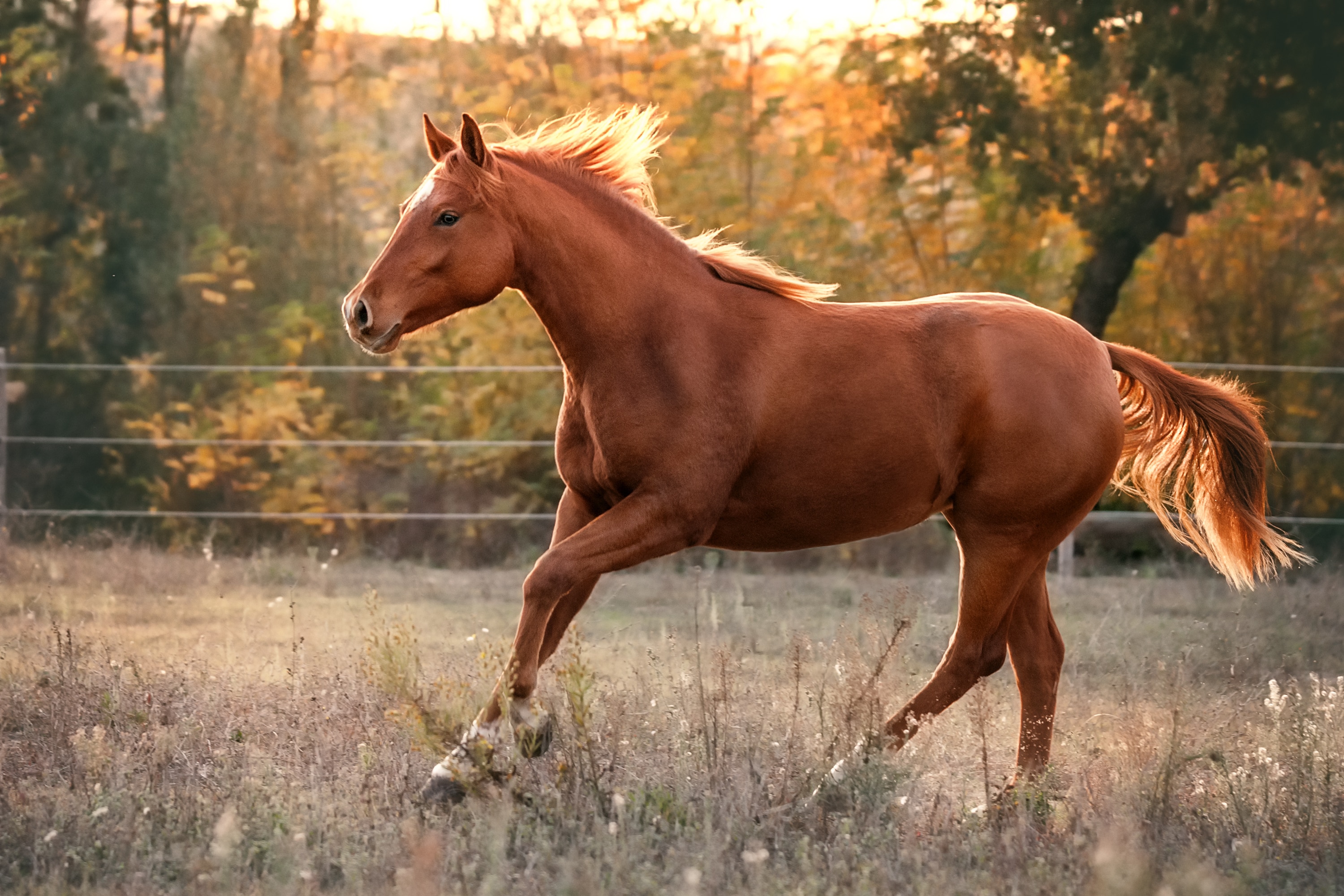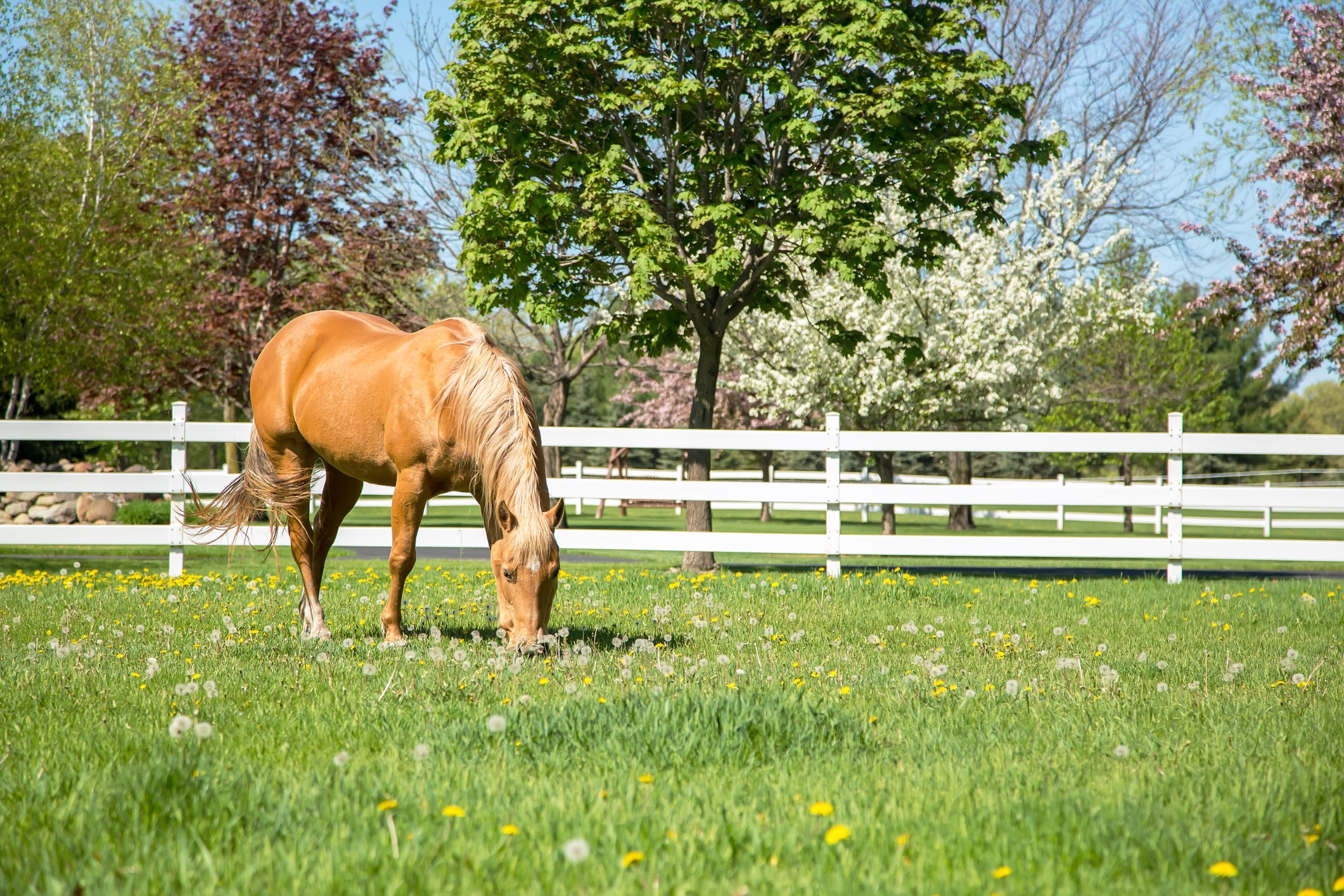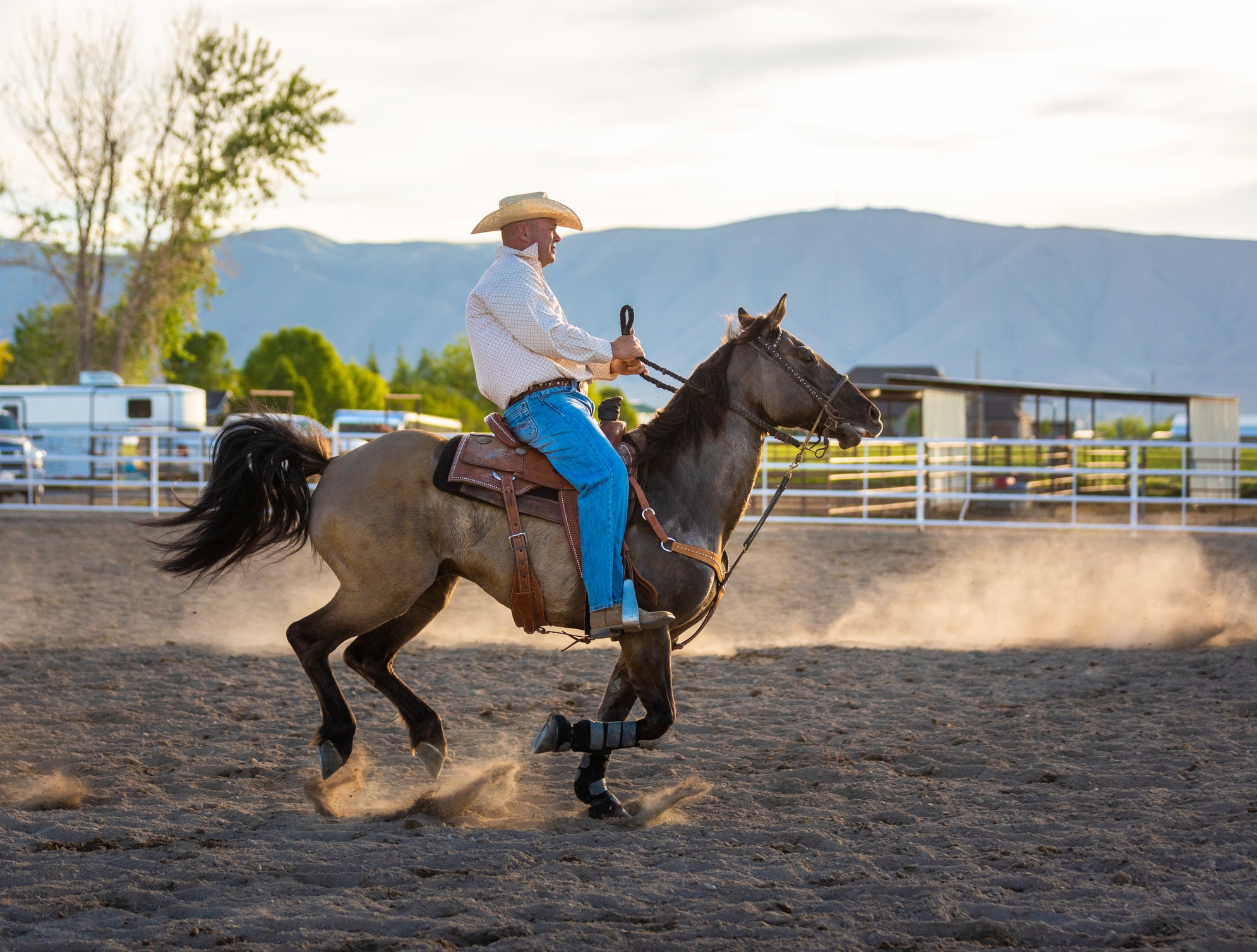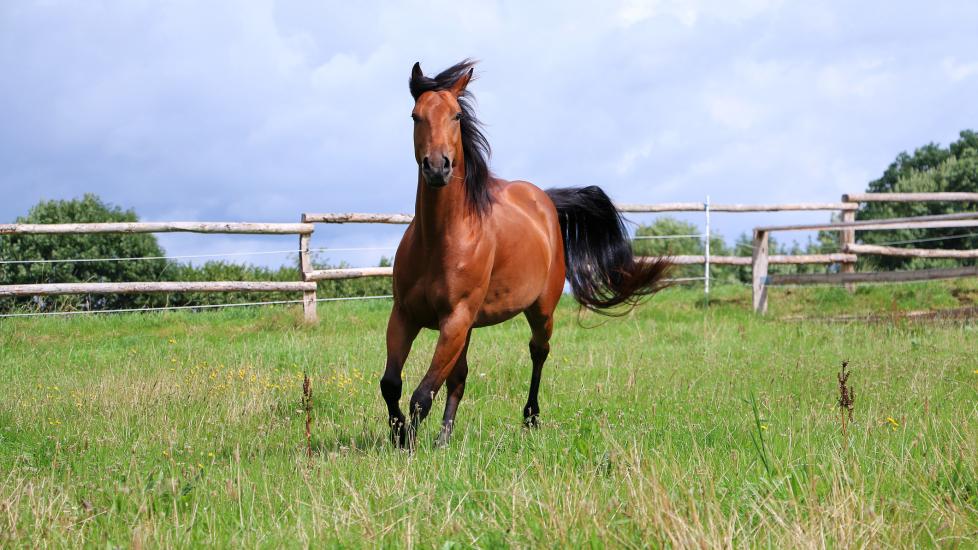American Quarter Horse
BiancaGrueneberg/iStock / Getty Images Plus via Getty Images
The American Quarter Horse is one of the oldest equine breeds in the U.S. and also the world’s most popular horse breed. The American Quarter Horse Association (AQHA) is the largest horse breed registry in the world, with more than 6 million registered horses.
Known for being able to run 1/4 mile in under 21 seconds, this is a fast and versatile horse that has an attractive appearance and equally winning personality. The breed's genetic makeup includes Spanish Barbs, Thoroughbreds, Mustangs, and English stock.
American Quarter Horse Snapshot
-
Height: 14.3 to 16 hands (57.2 to 64 inches)
-
Weight: 950 to 1,200 pounds
-
Lifespan: 25+ years
-
Colors: The wide variety of American Quarter Horse colors includes chestnut, sorrel, black, brown, gray, bay, palomino, and buckskin
Caring for an American Quarter Horse
American Quarter Horses are considered generally easy to keep because of their docile temperament and intelligence. Even when it comes to grooming, they don’t have any complex requirements.
These horses require a balanced, nutritious diet (fed in the right amounts to prevent unwanted weight gain), and plenty of daily exercise. Consistent exercise can help them maintain a strong body and healthy weight.
American Quarter Horses love to sprint, so offering them the chance to run every day is sure to make them happy.

American Quarter Horse Health Issues
Although the American Quarter Horse is typically a strong and healthy breed, there are some conditions that can be genetically inherited.
The University of California-Davis offers a genetic test to check for the following six diseases:
Glycogen Branching Enzyme Deficiency
Glycogen branching enzyme deficiency (GBED) is caused by a mutation that decreases the body’s ability to store glycogen. As a result, the brain, heart, liver, and skeletal muscles can’t function properly. Glycogen is the stored form of glucose (sugar),which is the body’s main source of energy.
GBED can cause pregnancy loss and stillbirths in American Quarter Horses, and foals that are born with it don’t survive long. It’s important to prevent passing GBED to offspring by genetically testing mares and stallions before breeding.
Hyperkalemic Periodic Paralysis
Hyperkalemic periodic paralysis (HYPP) is a genetically inherited muscular disease that is caused by a genetic mutation that results in an excessive amount of potassium in the blood (hyperkalemia). This causes a horse’s muscles to contract easier than normal, which can lead to unpredictable muscle tremors or paralysis. In severe cases this can lead to collapse and sudden death from cardiac arrest or respiratory failure.
HYPP can be confused with other conditions such as tying up, colic, seizures, or choking.
Work with a veterinarian to provide lifetime medical management for a horse with HYPP.
Malignant Hyperthermia
Malignant hyperthermia (MH) is a condition in which a horse develops a deadly high body temperature. MH can be triggered by excitement, stress, or some anesthesia drugs.
Symptoms include:
-
Irregular heart rhythm
-
Very high temperature
-
Muscle cramps
-
Shallow breathing
-
Sweating
Malignant hyperthermia is a medical emergency and is usually fatal.
Myosin-Heavy Chain Myopathy
Myosin-heavy chain myopathy (MYM) is a genetic disorder that involves muscle loss or damage. There can be two different presentations to the disease.
-
Immune mediated myositis (IMM) is characterized by severe muscle atrophy occurring after an autoimmune event, which is caused by the body’s cells attacking themselves.
-
Severe muscle pain and episodes of “tying up” (cramping of the muscles) can cause damage to the muscles. This is typically not associated with exercise and may or may not also include muscle atrophy.
Symptoms of MYM include:
-
Muscle atrophy
-
Muscle swelling
-
Cramping
-
Pain
-
Stiffness
A veterinarian can help identify triggers that cause the horse’s immune system to attack skeletal muscle cells, and they can recommend treatment options. Some of the triggers that can lead to a MYM event include:
-
Respiratory infections
-
Pigeon fever
-
Vaccinations that cause muscle damage (such as influenza, rhinovirus, and strangles vaccines)
-
Immune stimulants
-
Muscle damage
Polysaccharide Storage Myopathy Type 1
Polysaccharide storage myopathy type 1 (PSSM1) is a disorder that results in abnormal accumulations of glycogen (the storage form of glucose or sugar) that can lead to painful muscle cramping—“tying up.”
Symptoms of PSSM include:
-
Soreness
-
Weakness
-
Cramping
-
Stiffness
-
Reluctance to move
-
Sweating
-
Shifting lameness
-
Muscle tremors
-
Firm/hard muscles
-
Pawing
-
Stretching out
-
Poor performance
Proper diet and exercise can help control this condition.
Hereditary Equine Regional Dermal Asthenia
Hereditary equine regional dermal asthenia (HERDA) affects collagen in the skin, leading to injuries and wounds that heal slowly. Collagen is the structural protein of the skin that provides its strength and elasticity. Symptoms include skin that stretches, scars, and sloughs.
There’s no treatment for HERDA, and even a saddle can cause tears in the skin. Unfortunately, humane euthanasia is often the only option.
What To Feed an American Quarter Horse
Quarter Horses should be fed a diet that provides the right balance of nutrients to maintain their strength and a healthy weight. The amount a horse needs to eat daily depends on factors like their size, age, and activity level. Avoid overfeeding American Quarter Horses, as excess weight can lead to health problems like metabolic disorders.
Most horses are given a combination of hay, pasture, and grain, depending on their lifestyle and energy needs.
If your Quarter Horse has been diagnosed with a medical condition such as HYPP, your veterinarian can provide recommendations regarding the best foods and supplements to control or prevent symptoms and maintain your horse’s health.

American Quarter Horse Disciplines
American Quarter Horses are recognized for their versatility. They can do well in a variety of disciplines, such as:
-
Racing
-
Trail riding
-
Ranching
-
Dressage
-
Barrel racing
-
Roping
-
Reining
-
Jumping
The All American Quarter Horse Congress, which is the biggest single-breed horse show, is an annual event hosted by the Ohio Quarter Horse Association. Equestrians compete in a wide range of disciplines that showcase this breed’s capabilities.
In addition to work and equine sports, American Quarter Horses can also be used in equine therapy.

American Quarter Horse Personality and Temperament
Every horse is a unique individual with distinctive traits. But in general, American Quarter Horses have a wonderful disposition. They’re calm, intelligent, gentle, eager to please, and easy to handle and train. These characteristics make them a perfect choice for equestrians of all experience levels, including beginners.
Whether you’re looking for a work horse, a horse for leisure riding, or a horse to compete and race with, the strong, friendly, and dependable American Quarter Horse can be your perfect match.
American Quarter Horse Training
Training an American Quarter Horse shouldn’t be too challenging, as these horses are known for their intelligence and willingness to please their owners and trainers. Never be aggressive or harsh while training your horse. Take your time, be patient, and be consistent.
No matter what you’re training your horse for, use a slow and steady approach, moving from simple and basic commands and tasks to those that are more advanced. You’ll both enjoy the time you spend together by ensuring training sessions are positive experiences.
American Quarter Horse Grooming Guide
When it comes to grooming an American Quarter Horse, following a standard equine grooming routine while using the right tools will help your horse maintain a clean and healthy coat.
As you groom, check their whole body for signs of injury, infection, or irritation. Examine their ears, nostrils, and eyes, and clean them gently with a damp cloth if necessary.
Coat Care
Set a schedule for caring for your American Quarter Horse’s coat. Depending on your horse’s activity, they might need to be groomed more often, but once a week is the minimum.
To remove debris and dirt from the coat, use a curry comb and dandy brush. Use soft-bristled brushes on sensitive areas like the face to ensure your horse’s comfort.
A mane and tail brush can effectively remove dirt and tangles to keep the hair smooth, while a shedding blade can remove loose hair from your horse’s coat.
Hoof Care
It’s extremely important to check your horse’s hooves every day. Look for signs of injury or infection that would need to be addressed with the help of a veterinarian.
To carefully and thoroughly clean your horse’s hooves, use a high-quality hoof pick, which can effectively remove debris and dirt.
Work with a farrier to give your horse the right shoes. Examine the shoes daily to ensure they aren’t causing any problems.
American Quarter Horse FAQs
What are American Quarter Horses used for?
American Quarter Horses can be used for racing, ranching, showing, timed events, and trail riding. This breed is a good option for those who want to compete in equestrian events or who simply want a horse they can ride for pleasure.
Are American Quarter Horses good for beginners?
The American Quarter Horse is a great choice for beginners. These horses are docile and eager to please, as well as easy to train because they’re intelligent and friendly.
How did the American Quarter Horse get its name?
The American Quarter Horse got this name because they can run 1/4 mile in just 21 seconds, making them faster than other breeds when it comes to sprinting this distance. These horses can reach speeds of up to 55 mph for very brief periods.
How long do American Quarter Horses live?
On average, the American Quarter Horse lifespan is about 25 years, but some live well into their 30s. An individual horse’s lifespan will depend on various factors, from their genetics to how well they’re cared for.
How expensive is an American Quarter Horse?
The cost of an American Quarter horse can vary tremendously depending on what you plan to use them for. If you want a good, safe family horse, you may spend from $5,000 to $10,000. If you are looking for an elite show horse or breeding prospect, you can spend $50,000 and up.
